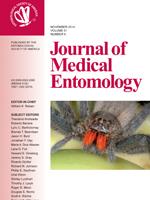Culicoides sonorensis (Wirth & Jones) is the principal North American vector of bluetongue virus (BTV). BTV infection of livestock is distinctly seasonal (late summer and fall) in temperate regions of the world such as California, which has led to speculation regarding vertical transmission of the virus within the midge vector as a potential mechanism for interseasonal maintenance (“overwintering”) of the virus. To evaluate potential vertical transmission of BTV in its midge vector, we fed adult midges BTV-spiked blood and used a BTV-specific quantitative reverse transcriptase polymerase chain reaction assay to evaluate parent, egg, and progeny stages of laboratory-reared C. sonorensis for the presence of viral nucleic acid. Whereas BTV nucleic acid was weakly detected in egg batches of virus-fed female midges, virus was never detected in subsequent progeny stages (larvae, pupae, and F1 generation adults). Similarly, BTV was not detected in pools of larvae collected from the waste-water lagoon of a BTV-endemic dairy farm in northern California during the seasonal period of virus transmission. Collectively, these results indicate that BTV is not readily transmitted vertically in C. sonorensis, and that persistence of the virus in long-lived parous female midges is a more likely mechanism for overwintering of BTV in temperate regions.
How to translate text using browser tools
1 March 2015
Lack of Evidence for Laboratory and Natural Vertical Transmission of Bluetongue Virus in Culicoides sonorensis (Diptera: Ceratopogonidae)
C. J. Osborne,
C. E. Mayo,
B. A. Mullens,
E. G. McDermott,
A. C. Gerry,
W. K. Reisen,
N. J. MacLachlan
ACCESS THE FULL ARTICLE
It is not available for individual sale.
This article is only available to subscribers.
It is not available for individual sale.
It is not available for individual sale.

Journal of Medical Entomology
Vol. 52 • No. 2
March 2015
Vol. 52 • No. 2
March 2015
bluetongue virus
Culicoides sonorensis
overwintering
vertical transmission




